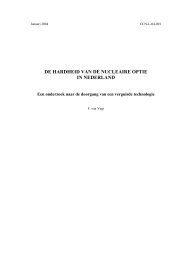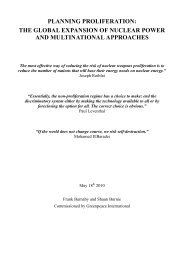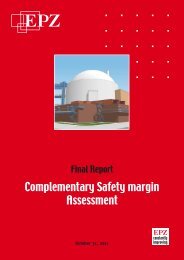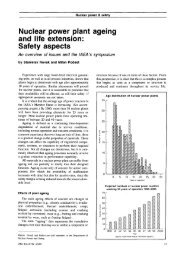CHERNOBYL; CHRONOLOGY OF A DISASTER - Antenna
CHERNOBYL; CHRONOLOGY OF A DISASTER - Antenna
CHERNOBYL; CHRONOLOGY OF A DISASTER - Antenna
You also want an ePaper? Increase the reach of your titles
YUMPU automatically turns print PDFs into web optimized ePapers that Google loves.
29 November: Ukrainian nuclear experts warn for Americium-241.<br />
This Pu-241 daughter emits alpha-radiation and is<br />
seen as more dangerous as its parent. Experts say alpha-radiation<br />
will be much higher in 50-70 years from now and hope<br />
it will not spread outside the 30km zone. (see August 4, 2005)<br />
1993<br />
January to March: Establishment of a thyroid centre in<br />
Gomel by the Otto Hug Strahleninstitut, Munich. Gomel is a<br />
large city with a population of 500 000 in the most severely<br />
contaminated region of Belarus.<br />
April: World Health Organization expects sharp rise in both<br />
leukemia and cancers, after numbers in both are increasing<br />
18 June: The international Shelter-2 competition ends. But<br />
Ukrainian government does not award a first prize. The<br />
French consortium Campenon Bernard receives a second<br />
prize. None of the 19 concepts on the shortlist fulfils all Ukrainian<br />
requirements. Unclear what happens next. Ukraine is<br />
looking to establish an international fund to raise money.<br />
22 October: Ukrainian government decided, due to electricity<br />
shortage not to close the remaining Chernobyl reactors and<br />
suspends a moratorium on new built<br />
9 December: Russian geochemist Valerin Kopejkin claims<br />
that if international radiation limits for Strontium-90 would be<br />
installed in the Ukraine, Kiev has to be evacuated.<br />
1994<br />
February: The U.S. Massachusetts Institute of Technology<br />
(MIT) releases report: emissions at Chernobyl five times<br />
higher than official IAEA estimate of 50 million curies. MIT<br />
claims 185-250 million Curies was released.<br />
9/10 October: Decision that remaining Chernobyl reactors<br />
will not be closed before 1996 at the earliest<br />
1995<br />
February: The first phase of the European Union-study for<br />
stabilizing the sarcophagus ends. The study claims it is a<br />
huge open radiation source. The consortium is pointing to the<br />
danger of collapse of the first sarcophagus and the problems<br />
of radioactive waste in case of constructing a second containment.<br />
Start of construction is foreseen in April 1996.<br />
March: 100 times more thyroid cancers in Gomel, Belarus,<br />
WHO claims in report published in British Medical Journal.<br />
13 April: President Leonid Kuchma declares Ukraine is ready<br />
to shut down the remaining reactors of the plant by the year<br />
2000. His statement follows a meeting with European Commission<br />
officials in Kiev.<br />
25 April: Ukrainian minister of public health Andrej Serdchuk:<br />
125,000 people died due to Chernobyl, 432,000 still treated,<br />
3.66 million affected.<br />
July: In a resolution adopted at a Kiev Conference organized<br />
amongst others by WHO, it is said that mental disorders<br />
spreading among Chernobyl-affected people<br />
20-23 November: new findings presented at a WHO conference<br />
in Geneva, suggest that radiation could also be increasing<br />
the incidence of strokes, heart attacks and liver disease,<br />
as well as damaging the brains of babies at the womb<br />
22 December: At a meeting in the Canadian capital Ottawa,<br />
Ukraine and the G7 group of the world's leading industrialized<br />
nations sign a Memorandum of Understanding, agreeing to<br />
close Chernobyl. It involves commitments worth a total of<br />
some US$2.3 billion in aid from the G7 to support Chernobyl's<br />
closure by the year 2000. The agreed package of loans<br />
for Ukraine's energy sector includes the completion of two<br />
more modern nuclear reactors at Rivne (R4) and Khmelnytsky<br />
(K2) stations in the west of the country. The aid package<br />
includes US$498 million in G7 member grants and $1.8 billion<br />
in loan financing from international agencies. Most of the<br />
grant money -- US$349 million - will be for nuclear decommissioning<br />
and safety. More than US$1.9 billion will be spent<br />
to upgrade nuclear plants and the energy sector as a whole.<br />
1996<br />
April: 20 seconds before the 1986 accident an earthquake<br />
occurred in that region. According to Russian scientists it is<br />
not impossible the seriousness of the accident could have<br />
been increased as a result of that.<br />
April: Genetic mutations have occurred twice as often in<br />
children of families exposed to the radioactive fallout as<br />
elsewhere<br />
8-12 April: The International Atomic Energy Agency (IAEA),<br />
together with the World Health Organization (WHO) and the<br />
European Commission (EC), organized the conference "One<br />
Decade after Chernobyl: Summing up the Consequences".<br />
The conclusions of the IAEA on the health effects of the Chernobyl<br />
disaster are as follows:<br />
- The death rate among "liquidators" did not exceed that for a<br />
corresponding age group.<br />
- Thus far, the only admitted health effect due to radiation is<br />
an increase in thyroid cancers in children. 890 cases were<br />
detected. In the coming decades, several more thousands of<br />
cases of thyroid cancer (4,000-8,000) can be expected.<br />
- No significant increase in leukemia has been found.<br />
- Future cancer deaths will be about 6,660: 2,200 among<br />
liquidators and 4,460 among residents and evacuees of contaminated<br />
areas.<br />
- Other health effects are related to psychological stress: fear<br />
of radiation and a distrust in the government.[1]<br />
See box: IAEA underestimates health consequences<br />
25 April: A French government minister acknowledged that<br />
the French were misled about the impact of the disaster.<br />
Whether forecasters on state television even told viewers that<br />
the radioactive cloud had stopped at France’s borders.<br />
26 April: The President of the UN General Assembly, Diogo<br />
Freitas do Amaral (Portugal), delivers a statement at the special<br />
commemorative meeting on the tenth anniversary of the<br />
Chernobyl accident. In his speech he states: “There continues<br />
to be an acute need for further assistance to the peoples and<br />
countries for whom Chernobyl represents a crushing burden<br />
[..]. To ignore this continuing humanitarian tragedy would be<br />
to reduce these people and the areas most affected to mere<br />
objects of scientific research.”<br />
November: Chernobyl shuts down reactor Number One. Only<br />
reactor Number Three remains in operation.<br />
11 November: Cases of thyroid cancer among children in<br />
Ukraine, Belarus and Russia are up by roughly 200 per cent<br />
compared to the 1980s. The WHO estimates that around 4<br />
million people in these three countries have been affected<br />
by the nuclear disaster. Roughly one million are undergoing<br />
medical treatment for consequential health impairments.<br />
December: Authorities of Belarus launched a campaign to<br />
return people to regions which have suffered from Chernobyl.<br />
Nesterenko (director of Institute for Radiation Safety) warns<br />
for a serious error.<br />
1997<br />
April: Belarus has to spent 25% of its national annual budget<br />
on dealing with the effects of the 1986 disaster.<br />
June: President Kuchma says Ukraine is spending US$1 billion<br />
a year to combat the aftermath<br />
November: At a conference in New York, dozens of nations<br />
collect $350 million to rebuild the rapidly deteriorating concrete<br />
sarcophagus. The reconstruction cost is estimated at<br />
$760 million.<br />
10 Nuclear Monitor 724
















![EPZ jaarverslag 2009 [PDF] - Laka.org](https://img.yumpu.com/40394048/1/190x190/epz-jaarverslag-2009-pdf-lakaorg.jpg?quality=85)
